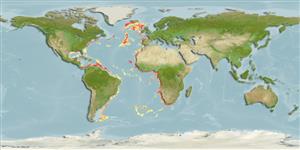Classification / Names
Common names | Synonyms | Catalog of Fishes (gen., sp.) | ITIS | CoL | WoRMS | Cloffa
Actinopterygii (ray-finned fishes) >
Lophiiformes (Anglerfishes) >
Ogcocephalidae (Batfishes)
Etymology: Dibranchus: Greek, di = two + Greek, brangchia = gills (Ref. 45335); tremendus: Named for its giant size and terrific spines, a species to be trembled at (= tremendus).
Environment / Climate / Range
Ecology
Marine; bathydemersal; depth range 750 - 2300 m (Ref. 40826). Deep-water, preferred ?
Western Central Atlantic: Gulf of Mexico and the Caribbean Sea. Eastern Central Atlantic: Gulf of Guinea to Namibia.
Size / Weight / Age
Maturity: Lm ? range ? - ? cm
Max length : 19.2 cm SL male/unsexed; (Ref. 40826)
Short description
Morphology | Morphometrics
Dorsal
soft rays
(total): 4-7;
Anal
soft rays: 4;
Vertebrae: 18 - 20. Tubercles without the radiating rows of spinules as seen in D. atlanticus (forming a shagreen). Spines of tubercles extremely long and stout , especially along sides of tail. Tubercles cover the surface of disk. Principal tubercles of ventral surface of tail very large and occupying entire ventral surface except for a few small tubercles in the median portion between anus and anal fin base. Cephalic lateral line count: subopercular usually 5 (4-5); preopercular usually 2. Firm skeleton; pliant skin, especially on ventral surface of disk. Fin without tubercles except at the extreme bases of the pectoral and caudal fins. Pectoral and pelvic fins both relatively long and slender in small individuals, shorter and broader with rays very fleshy in large ones (Ref. 40826).
Life cycle and mating behavior
Maturity | Reproduction | Spawning | Eggs | Fecundity | Larvae
Bradbury, M.G., 1999. A review of the fish genus Dibranchus with descriptions of new species and a new genus, Solocisquama (Lophiiformes, Ogcocephalidae). Proc. Calif. Acad. Sci. 51(5):259-310. (Ref. 40826)
IUCN Red List Status (Ref. 115185)
CITES (Ref. 94142)
Not Evaluated
Threat to humans
Harmless
Human uses
More information
Common namesSynonymsMetabolismPredatorsEcotoxicologyReproductionMaturitySpawningFecundityEggsEgg development
Age/SizeGrowthLength-weightLength-lengthLength-frequenciesMorphometricsMorphologyLarvaeLarval dynamicsRecruitmentAbundance
ReferencesAquacultureAquaculture profileStrainsGeneticsAllele frequenciesHeritabilityDiseasesProcessingMass conversion
Tools
Special reports
Download XML
Internet sources
